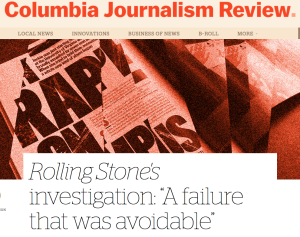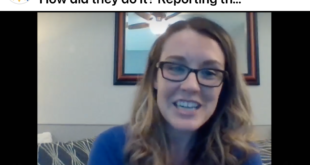Back in January, a month after Rolling Stone’s disaster of a story came to light, I offered some free advice.
This was soon after the magazine announced it would have Columbia Journalism School conduct an audit of the story and tell us what went wrong. The CJS report was released over the weekend, and it was everything I said it would be.
 The report seems to be thorough and zeroes in on the failures of the reporter and editors at Rollling Stone. It then follows up with some advice which, again, is exactly what I said in January.
The report seems to be thorough and zeroes in on the failures of the reporter and editors at Rollling Stone. It then follows up with some advice which, again, is exactly what I said in January.
To wit:
Rolling Stone’s repudiation of the main narrative in “A Rape on Campus” is a story of journalistic failure that was avoidable. The failure encompassed reporting, editing, editorial supervision and fact-checking. The magazine set aside or rationalized as unnecessary essential practices of reporting that, if pursued, would likely have led the magazine’s editors to reconsider publishing Jackie’s narrative so prominently, if at all. The published story glossed over the gaps in the magazine’s reporting by using pseudonyms and by failing to state where important information had come from.
No newspaper editor I know, including the smallest weeklies — perhaps, especially the smallest weeklies — would have published that story the way it was written. The holes were obvious. The skepticism I had, and many shared, was engendered simply by reading the story — without knowing any of the background.
It was a story about sexual assault and, as I wrote four months ago, those are particularly tricky stories. They need extra attention to detail, not a hands-off approach or — worse — a rationalization that because the names were changed (anonymous sources) it was OK to scrimp on the fact-checking.
Again from Columbia Journalism School’s report:
Yet the editors and Erdely have concluded that their main fault was to be too accommodating of Jackie because she described herself as the survivor of a terrible sexual assault. Social scientists, psychologists and trauma specialists who support rape survivors have impressed upon journalists the need to respect the autonomy of victims, to avoid re-traumatizing them and to understand that rape survivors are as reliable in their testimony as other crime victims. These insights clearly influenced Erdely, Woods and Dana. “Ultimately, we were too deferential to our rape victim; we honored too many of her requests in our reporting,” Woods said. “We should have been much tougher, and in not doing that, we maybe did her a disservice.”
Even if it weren’t a sexual-assault story, the fundamentals of journalism have to be followed every time, CJS’s report emphasized:
But three failures of reporting effort stand out. They involve basic, even routine journalistic practice – not special investigative effort. And if these reporting pathways had been followed, Rolling Stone very likely would have avoided trouble.
That’s the job of editors. Every good reporter gets passionate about a story. It’s why we want them to pursue the tough ones. The passion shows in their writing.
Often, it shows in their reporting too. They go where few have gone before, and they ask questions no one else has asked. But the closer the reporter gets, the more passionate about the story, the greater the need for a strongly independent editor to poke, prod, doubt and demand:
Investigative reporters working on difficult, emotive or contentious stories often have blind spots. It is up to their editors to insist on more phone calls, more travel, more time, until the reporting is complete. Woods did not do enough.
One of the reasons I said earlier that not even the smallest weekly newspaper would have run the story as written is because that newspaper’s editor understands completely how fragile is the publication’s credibility.
Screw up once, and your readers never forget. The responsibility lies with one person — not a raft of editors, or corporate lawyers, or some other chain of command in which many have a say but no one is culpable. At one newspaper, when I arrived virtually everyone gave the same response when I demanded to know how a mistake got into print.
“That’s not my job,” they said.
My reply: “That’s everybody’s job.”
The editors invested Rolling Stone’s reputation in a single source. “Sabrina’s a writer I’ve worked with for so long, have so much faith in, that I really trusted her judgment in finding Jackie credible,” Woods said. “I asked her a lot about that, and she always said she found her completely credible.”
If your mother says she loves you, check it out. That’s all I have to say about that kind of thinking.
Then there’s also the issue, which I wrote about in January, of shaping the facts to fit the story. Most stories worth reading can get pretty messy, if you’re willing to acknowledge their complexity. It’s as much a sin to omit information that doesn’t fit the narrative as it is to fabricate.
The problem of confirmation bias – the tendency of people to be trapped by pre-existing assumptions and to select facts that support their own views while overlooking contradictory ones – is a well-established finding of social science. It seems to have been a factor here. Erdely believed the university was obstructing justice.
How to fix it? Well, stick to what — I hope — some bastard of a city editor told you over and over until you got it right.
I had a pretty simple rule (and, yes, I could be a bastard sometimes): The subjects of your story should never be surprised by what they read in it.
You have to confront them with the facts, at least as you know them. That’s one of the ways you find out whether those facts are true.
And it’s one of the huge problems with Rolling Stone’s story. All these fake names and anonymous sources …. They never even talked to some of the people who were accused, quoted and described in the story. The rationale, I guess, was that by using made-up names the editors somehow thought these people weren’t real.
In one case — the alleged attacker — it seems apparent there was no such person. Kind of a big hole, yes?
Yet Rolling Stone’s senior editors are unanimous in the belief that the story’s failure does not require them to change their editorial systems. “It’s not like I think we need to overhaul our process, and I don’t think we need to necessarily institute a lot of new ways of doing things,” Dana said. “We just have to do what we’ve always done and just make sure we don’t make this mistake again.” Coco McPherson, the fact-checking chief, said, “I one hundred percent do not think that the policies that we have in place failed. I think decisions were made around those because of the subject matter.”
Here are a few suggestions: No more anonymous sources. No more fake names. No more writing about people without actually talking to them (emails don’t count). No more taking the word of anybody about anything without confirming it. I think that’s a good start.
Here’s a conclusion from the folks at Columbia Journalism School:
The particulars of Rolling Stone’s failure make clear the need for a revitalized consensus in newsrooms old and new about what best journalistic practices entail, at an operating-manual-level of detail.
Really? I’m pretty sure there’s already a clear consensus among newsrooms old and new about what constitutes the minimum in being fair, accurate and responsible.
Rolling Stone just didn’t do it.
 Nevada Press Association The best in Nevada journalism since 1924
Nevada Press Association The best in Nevada journalism since 1924



